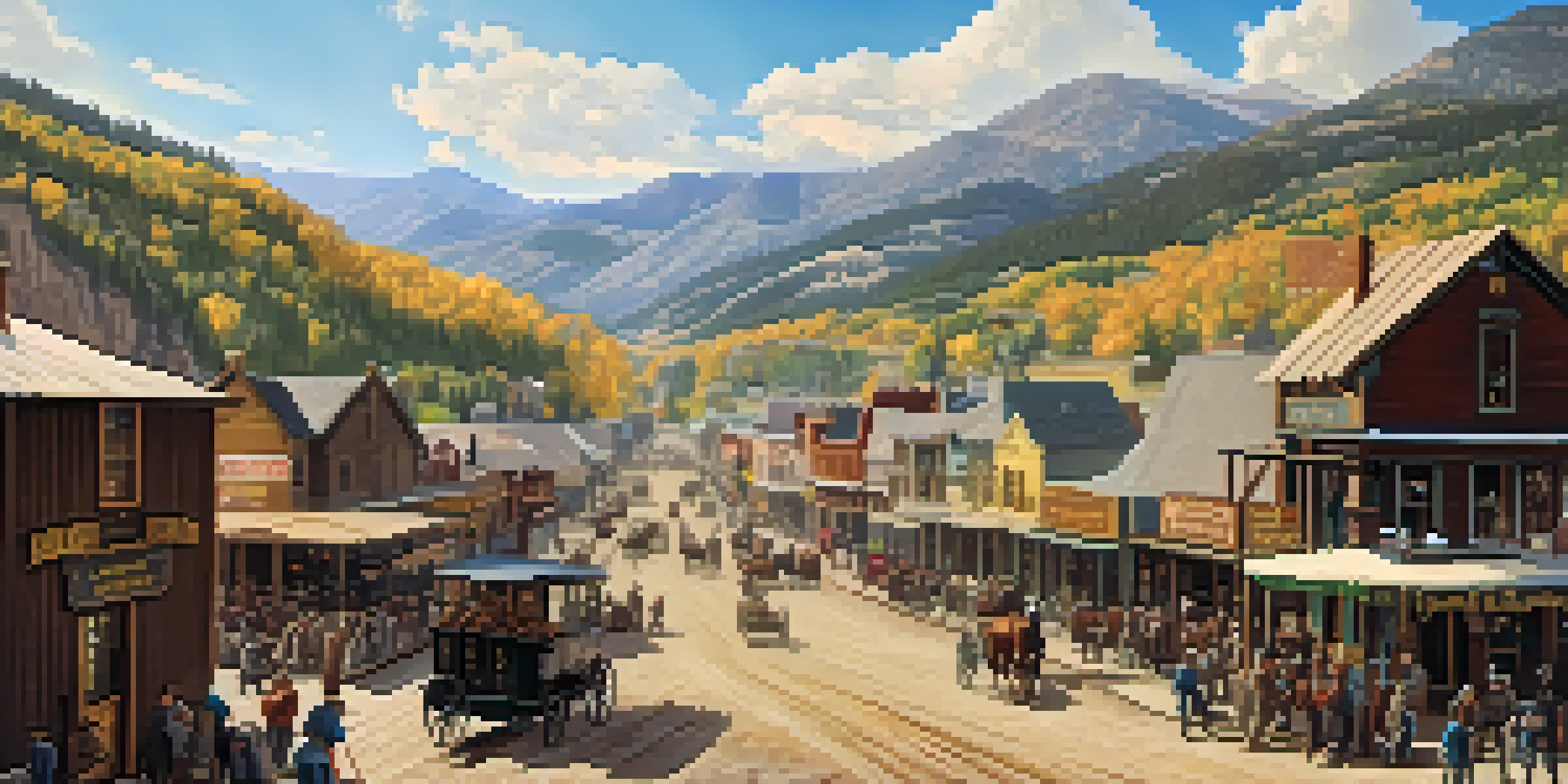Mining Towns: Echoes of the Past in Colorado's Communities

The Rise of Colorado's Mining Towns in the 19th Century
In the mid-1800s, Colorado was a land of promise, drawing fortune seekers from all over the country during the Gold Rush. Towns like Central City and Leadville sprang up almost overnight, fueled by the dreams of striking it rich. These communities were often bustling with activity, from saloons to general stores, reflecting the hopes and aspirations of their inhabitants.
Mining is a dangerous profession, but it has always been a significant part of our American heritage.
As miners dug into the earth, they uncovered not just gold but also silver, lead, and other precious minerals. This mining boom transformed Colorado's economy, leading to rapid population growth and the establishment of new towns. Each mining town had its own unique character, shaped by the resources extracted and the people who lived there.
However, this prosperity was often fleeting. As mines depleted, towns that once thrived began to decline. Many mining towns became ghost towns, leaving behind echoes of their vibrant past, which continue to intrigue historians and visitors alike.
Life in the Mining Towns: Community and Culture
Life in Colorado's mining towns was a tapestry of diverse cultures and communities. Immigrants from Europe, Asia, and beyond flocked to these areas, bringing their traditions and customs. This melting pot created a rich cultural landscape, where festivals, music, and food reflected the varied backgrounds of the miners and their families.

Despite the harsh working conditions and long hours, a sense of camaraderie often blossomed among the miners. They banded together to form unions, advocating for better wages and safer working environments. These efforts laid the groundwork for labor rights movements that would shape the future of work in America.
Mining Towns: A Cultural Melting Pot
Colorado's mining towns became vibrant communities where diverse cultures blended, creating a rich tapestry of traditions and shared experiences.
The social fabric of these towns was tightly woven through shared experiences, whether it was celebrating a successful haul or mourning the loss of a fellow miner. Even today, remnants of this culture can be felt in annual celebrations and local gatherings, keeping the spirit of the mining towns alive.
The Role of Women in Mining Towns
While mining was traditionally seen as a man's domain, women played vital roles in these communities. Many women managed homes and raised families, while others took on jobs in boarding houses, saloons, and stores. Their contributions were often overlooked, yet they were essential for the survival and growth of these towns.
The past is never dead. It's not even past.
Women formed their own social networks, providing support to one another in challenging times. They organized events, established schools, and even advocated for social reforms, such as women's suffrage. These efforts helped to empower women and pave the way for future generations.
Today, the legacy of these pioneering women is celebrated in various forms, from historic sites to local museums. Their stories serve as a reminder of the resilience and strength that characterized life in mining towns.
Environmental Impact of Mining in Colorado
Mining, while economically beneficial, left a significant mark on Colorado's landscapes. The extraction of minerals often led to deforestation, soil erosion, and water pollution, creating challenges for both the environment and the communities that depended on it. This environmental toll is a critical aspect of the mining narrative.
In recent years, efforts have been made to address these environmental impacts through restoration projects and sustainable mining practices. Local organizations are working to rehabilitate damaged areas, aiming to restore the natural beauty of the region. This shift reflects a growing awareness of the importance of environmental stewardship.
Environmental Challenges of Mining
The mining boom in Colorado significantly impacted the environment, leading to issues such as deforestation and water pollution that are still being addressed today.
As visitors explore these historic mining towns, they can also engage with this modern narrative, learning about the balance between economic development and environmental protection. Understanding this relationship is crucial for preserving Colorado's legacy for future generations.
Ghost Towns: Remnants of a Bygone Era
Many of Colorado's mining towns have faded into ghost towns, leaving behind remnants of their once-thriving communities. Places like Cripple Creek and St. Elmo serve as time capsules, showcasing the architecture and lifestyle of the mining era. These sites attract history enthusiasts and ghost town explorers eager to uncover their stories.
Walking through these deserted streets, you can almost hear the echoes of laughter and labor that once filled the air. The crumbling buildings tell tales of prosperity and decline, a poignant reminder of the impermanence of success. Each ghost town has its own unique history, contributing to Colorado's rich tapestry of mining heritage.
Efforts to preserve these historical sites allow visitors to step back in time while fostering an appreciation for the challenges faced by those who lived there. Ghost towns serve not only as tourist attractions but also as educational resources that illuminate the complexities of Colorado's mining past.
Cultural Heritage and Tourism in Mining Towns
Today, many former mining towns have transformed into vibrant tourist destinations, celebrating their unique cultural heritage. Festivals, historical reenactments, and guided tours offer visitors a glimpse into the lives of those who once called these towns home. This shift has provided economic opportunities for local communities, helping to sustain their legacies.
Local artisans and businesses have embraced the mining heritage, creating products and experiences that reflect the town's history. From handcrafted jewelry to authentic dining experiences, these offerings allow visitors to connect with the past in meaningful ways. It's a beautiful blend of history and entrepreneurship that breathes new life into these communities.
Ghost Towns: Echoes of History
Many former mining towns now stand as ghost towns, preserving the stories and architecture of a bygone era while attracting tourists and history enthusiasts.
Tourism not only supports the economy but also fosters a sense of pride among residents. As they share their stories and heritage, they ensure that the echoes of the past continue to resonate in the present.
Preserving the Legacy of Colorado's Mining Towns
Preservation efforts are crucial for maintaining the rich history of Colorado's mining towns. Local governments, historical societies, and community organizations are working together to protect these sites from deterioration. By securing funding and resources, they aim to restore and maintain the structures that tell the stories of the past.
Education plays a vital role in these preservation efforts. Schools and museums often collaborate to create programs that teach visitors about the mining era, highlighting its impact on the region. Engaging the younger generation fosters a sense of responsibility for preserving this legacy.

As we reflect on the past, it's essential to recognize the lessons learned from these mining towns. By valuing and preserving their history, we ensure that future generations can appreciate the sacrifices and triumphs of those who came before them.